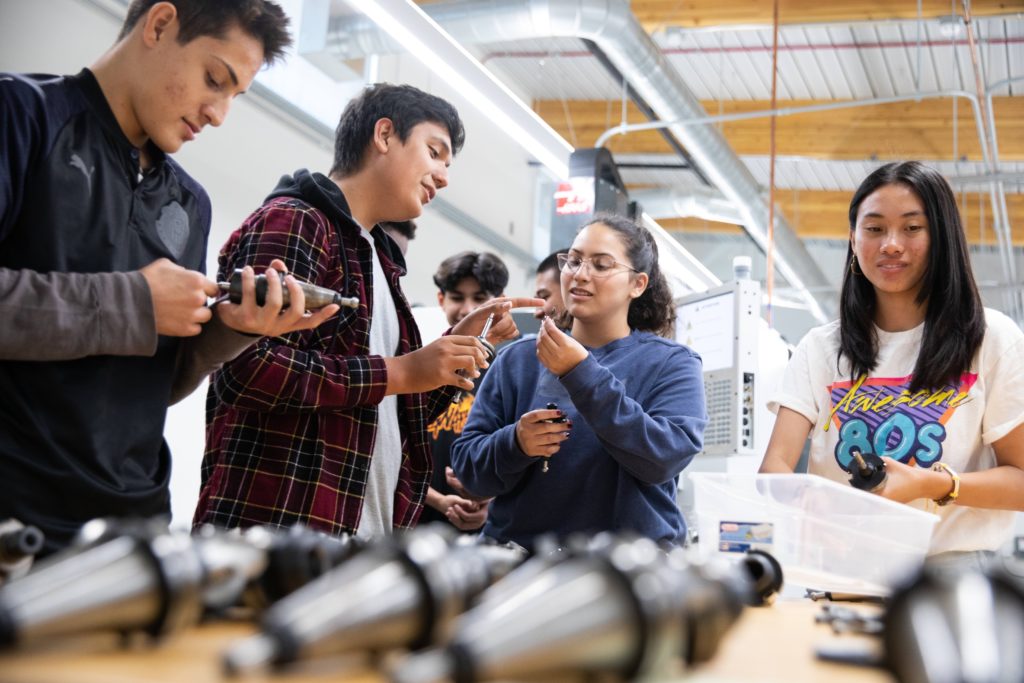We must help high school juniors and seniors stay on the college path
 Photo: Linked Learning Brotherhood
Photo: Linked Learning Brotherhood
Students in a Linked Learning Engineering science Pathway.
 Photograph: Linked Learning Alliance
Photograph: Linked Learning Alliance
Students in a Linked Learning Engineering Pathway.
Beyond California, loftier school juniors and seniors are watching as milestones evaporate in the coronavirus crisis. Proms. Graduations. Higher tours. Performances. Sports. Even finals.
The feeling of loss is universal. But for youth who lack the safety cyberspace of privilege, the pandemic has exacerbated existing inequities and threatens to derail their paths to college and career.
Amid unprecedented school closings, too many students are falling off the radar. Educators are working tirelessly to find them and address basic needs while pivoting to digital learning. Only they know it's not enough — we must do more to keep instruction connected to purpose for the students caught at the epicenter of the COVID-19 storm.
Leaders accept taken steps in the right direction, easing high school graduation and post-secondary admissions requirements. But to set students for the giant bound from high school to higher, we demand to juggle the benefits of maximum flexibility with the possibility that lowered expectations could diminish motivation and dim aspirations.
Before this crunch started, California had another crisis brewing. Even equally loftier schoolhouse graduation rates increased steadily, merely over half of California's college students earned their associate degrees at a community college in iii years or available'south degrees in half dozen years.
These information points reverberate holes in the post-secondary pipeline with far as well many low-income students slipping through during the transition from high school to higher.
This fifty-fifty includes young people who are continued to purpose and engaged in high-quality college and career preparation such as Linked Learning, which blends real earth learning with rigorous academics and comprehensive supports.
Nosotros need to exercise more to maintain connections, dilate pupil supports and bridge the gap between K-12 and college teaching. This is the time to break downwardly silos and connect proven solutions from both sectors.
Here are steps nosotros can have to support juniors and seniors at present:
Raise student voices — and rapidly respond. No other segment of students has seen their teaching come to such a screeching and indecisive halt. Nosotros must listen to students, understand their perspectives, larn from their experiences and treat them as equal partners in shaping their education and future.
For example, social distancing has eliminated near piece of work-based learning and internships, opportunities for accelerated higher credits and student back up services merely as students wrestle with tough decisions. Should they forego college and work to back up their families? Should they rethink their college plans to exist closer to home? By being proactive at present, we can go along young people engaged and underscore their importance in developing solutions.
Connect critical supports — in high school and college. Students need individualized pathways from high schoolhouse through college and career that embed comprehensive supports similar counseling and individualized supplemental education. While this support helps students succeed in high schoolhouse, nosotros take seen young people struggle to persist in less-supportive college environments. Aligning supports from high school to and through college is a natural starting point.
Advance college-level learning — and brand information technology meaningful. In that location is no return to the fashion things were for electric current high school juniors and seniors. But we tin can be proactive to help catapult them forward. It'due south time to explore effective practices for accelerated learning across systems. Thousand-12 and college leaders should rethink summertime to supercede lost learning time. And we must be brave plenty to re-imagine the concluding year of loftier schoolhouse and first year of college.
Dual enrollment, for instance, helps students graduate high school, go to higher, complete college degrees faster and with less debt. We must too involve industry as partners to ensure that we don't sacrifice a generation of talent in the inevitable economic downturn.
California could launch a college-centered approach to apprenticeship that serves equally an 11th- and twelfth-grade capstone feel, helping students earn industry credentials and university admissions credit. Together these options would increase educatee motivation, reduce financial brunt and meliorate the odds of earning a degree.
In times of crisis, nosotros gain clarity,and the opportunity to do amend. There is no greater time for M–12 and post-secondary leaders to coalesce around shared goals for learners. To practice so requires concerted and systemic efforts to eliminate silos, accelerate what works and, most chiefly, to put students' needs at the heart by giving them a seat at the conclusion-making table.
The time is at present to keep the classes of 2022 and 2022 on a path to purpose — and to forge solutions that improve didactics for all.
•••
Elisha Smith Arrillaga, Ph.D. is Executive Directors of The Didactics Trust-Westward. Anne Stanton is President of the Linked Learning Alliance.
The opinions in this commentary are those of the author. Commentaries published on EdSource represent viewpoints from EdSource's wide audience. Every bit an independent, not-partisan organization, EdSource does not take a position on legislation or policy. Nosotros welcome guest commentaries representing diverse perspectives. If yous would like to submit a commentary, delight review our guidelines and contact united states of america.
To get more reports like this one, click here to sign upward for EdSource's no-price daily email on latest developments in pedagogy.
Source: https://edsource.org/2020/we-must-help-high-school-juniors-and-seniors-stay-on-the-college-path/632046
